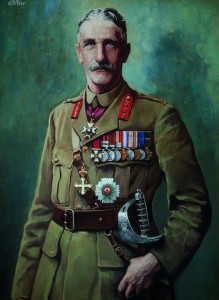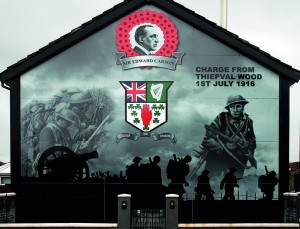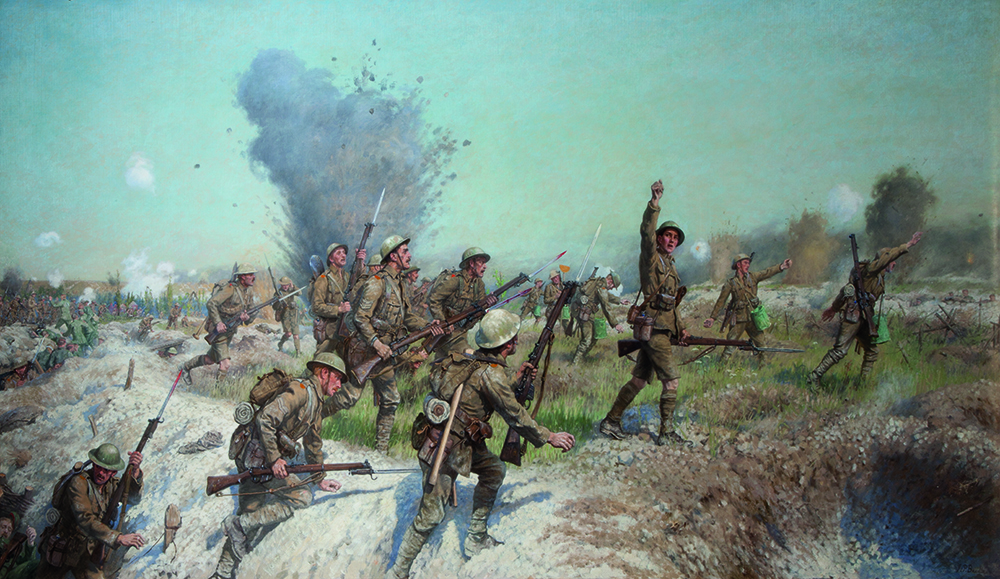‘I do wish we were not the “Ulster” Division but just the 36th’
Published in Decade of Centenaries, Features, Issue 4 (July/August 2014), Volume 22
Portrait of Major-General Oliver Stewart Wood Nugent, GOC of the 36th Ulster Division for most of the war, by William Conor. (Belfast City Council)
As the centenary of the Battle of the Somme appears over the horizon, plans for the celebration, contemplation and commemoration of the 36th Ulster Division are well under way. In venerating the tens of thousands who fought on the battlefields of the Western Front one name will seldom be mooted. For 31 of the 37 months that the Ulster Division spent on operational services, its general officer commanding (GOC) was Major-General Oliver Stewart Wood Nugent. At first glance, Nugent seemed the ideal choice to command the Ulster Division. The scion of a prominent Protestant landowning family, this tough-minded professional soldier had proved his military capabilities during the Boer War, and had, crucially, trumpeted his impeccable unionist credentials with his involvement in the Ulster Volunteer Force. Nevertheless, his uncompromising personality and his disregard for domestic political sensitivities soon caused irreconcilable rifts within the Ulster Division and its supporters.
Military career
Like many from a traditional gentry family, Nugent attended Harrow School before continuing his education at Sandhurst, finally joining the 60th Rifles (the King’s Own Rifle Corps) in 1883. He served with distinction during the Battle of Talana Hill, the first major clash of the Second Boer War. With characteristic determination and a bravery that would define his subsequent career, he led his men in a forward charge under heavy fire, receiving wounds in the knee, hip and back. On reaching the crest, his small contingent of men came under fire from British artillery, causing numerous casualties. The British finally withdrew to Ladysmith but left their wounded behind. Nugent spent almost a year as a prisoner of war before being invalided home following the relief of Pretoria. Never fully recovering from his wounds, he regularly suffered bouts of extreme pain.

Following a three-year appointment as a colonel in the Hampshire Infantry Brigade, Nugent returned on half pay to an Ireland in the throes of the Home Rule crisis, soon becoming involved in raising and training the Ulster Volunteer Force (UVF) with his friend and neighbour Lord Farnham. Nevertheless, he felt deeply uneasy with the ‘Ulster’ identity of the organisation, renaming his division the Cavan Volunteer Force (CVF) in order to stress the reality of its geographical and political isolation from north-east Ulster. He deemed the CVF a police rather than a political force, formed for ‘defence and not aggression’, and not intended to be used against any of the armed forces of the Crown, but rather ‘to assist them . . . in the maintenance of peace and security’. Retrospectively Nugent felt profoundly uncomfortable with his involvement in the UVF, believing that he had compromised his professional standing and stating that he ‘disagreed all along on the policy which created the UVF’ and that ‘the physical force movement was a mistake and the arming of Ulster still a greater mistake’. His unease over this episode deepened an innate distrust of politicians and further contributed to the difficult relationship he would have with them during the war.
Appointed commander of the Ulster Division
In August 1914 Nugent received an appointment to secure the Hull defences, but his extensive military experience ensured a divisional command, serving first in the Ypres salient. In September 1915 he became GOC of the newly formed 36th (Ulster) Division, yet his personal characteristics, combined with the pressures of commanding such a heavily politicised unit of men, soon produced deep conflicts within the division and the Ulster unionist movement. He remonstrated: ‘how I hate the sordid outlook of the politician. I think the Irish brand is worse than any other . . . I do wish we were not the “Ulster” Division but just the 36th.’ Immediately upon taking command, Nugent imposed his ruthless professional standards, removing those officers who failed to make his exacting grade. Many of these officers, however, had strong political, social and familial links to Ulster unionism, which served to antagonise an establishment already suspicious of him.
His relationship with Ulster politicians deteriorated steadily as the war progressed. Another corres-pondence declared that ‘they are the most self-centred people I have ever met. If you are not Ulster and if you don’t subscribe to every Ulster prejudice and if you are not as intolerant as they are, they will have nothing to do with you.’ The distance between them became insurmountable when, against the backdrop of the heightening recruitment crisis, unionist leaders pursued a partitionist settlement excluding Donegal, Monaghan and Cavan, prompting Nugent to assert that he ‘could not have believed it would have been possible that so many whom we know would have been ready to sacrifice their pledged word. Solemn covenants, old principles, calls of patriotism count for nothing . . .’.
Offending letter

The charge of the Ulster Division, Somme, 1st July, 1916, by James Prinsep Beadle. Following the devastating casualties suffered by the 36th at the Somme, there were not enough Irish recruits to bring the division up to strength. One radical solution supported by Nugent involved the amalgamation of the two serving Irish divisions. (Belfast City Council)
Following the devastating casualties suffered by the 36th at the Somme, there were not enough Irish recruits to bring the division up to strength. One radical solution supported by Nugent involved the amalgamation of the two serving Irish divisions—‘I am sure there could be no better cure for Irish home troubles than that Protestants and Catholics should fight together in the same unit’—and conscription, which he felt would be ‘the moral regeneration’ that could ‘kill politics for all time in Ireland’. Eventually, the government decided to preserve the two Irish divisions by drafting in non-Irish soldiers, although the division remained under strength. When asked to compose a Christmas message for the Belfast News Letter, Nugent seized the opportunity to dispense some hard truths, happily remarking to Catherine, ‘I am giving them beans and no mistake, laying it on with scorpions’. He forwarded the press cutting from the Belfast News Letter a few days later with his message to the Ulster ‘Loafers’—‘I have had two letters of protest already which shows it left a sting’.
The letter caused deep offence to Ulster unionists, especially when its message found its way onto the placards sported by nationalist demonstrators in Dublin. While the press called for Nugent’s dismissal, James Craig allegedly refused to have any contact with the Ulster Division while Nugent remained in command. His already strained relationship with Craig collapsed completely over the recruitment issue. On hearing reports of Craig’s apparent dismissal of the recruitment crisis in order to focus on Home Rule, Nugent stormed that he ‘ought to be shot if that is true’; nevertheless, the letter failed to stimulate Irish recruitment and signalled the end of his fruitless relationship with the Ulster unionist leadership.
The end
Nugent’s involvement in the Great War ended where it began, in the Ypres Salient, an area he had come to despise. On 5 May 1918 Major-General Clifford Coffin VC, ten years his junior, took over command. At the handover of the division, however, Nugent remained one of only two New Army divisional generals who had come out to France in 1915 with their original commands. In July 1918 Nugent assumed command of the Meerut Division, being joined by his wife and his son, St George. After his retirement from the army, he finally returned home to his native Cavan in the autumn of 1920 and later received a knighthood for his war services.
Nugent died at Farrenconnell on 31 May 1926 shortly after catching a chill that developed into pneumonia. Buried in Mount Nugent, a memorial was later erected in the parish church. Shortly after his death, a service took place in St Anne’s Cathedral in Belfast. Although no senior political member of the Northern Ireland government attended, hundreds of former members of the Ulster Division did—a fitting testament to their respect for their former GOC. In the words of one of his contemporaries, ‘you have done great things and come through critical times, and never with anything but honour’. A committed, professional and unflinching Anglo-Irish officer, Nugent had been steadfast in his command of one of the most heavily politicised New Army divisions of the Great War. Perhaps as Ireland moves through its decade of remembrance it is timely to reflect on a speech Nugent delivered at Virginia, Co. Cavan, in 1923: ‘The day is not, I hope, far distant when the memory of all those of our country who gave up their lives for Civilization as we interpret it and in obedience to what they believed to be their duty will be honoured and perpetuated in every town and village in Ireland’.
Pauline Mitchell works in Derry City Council’s Heritage and Museum Services.
Read More: Old English Catholic background
Awarded a papal medal!
Further reading
T. Bowman, Irish regiments in the Great War (Manchester, 2006).
K. Jeffery, Ireland and the Great War (Cambridge, 2000).
J. McGaughey, Ulster’s men: Protestant unionist masculinities and militarization in the north of Ireland 1912–1923 (Montreal, 2012).
















